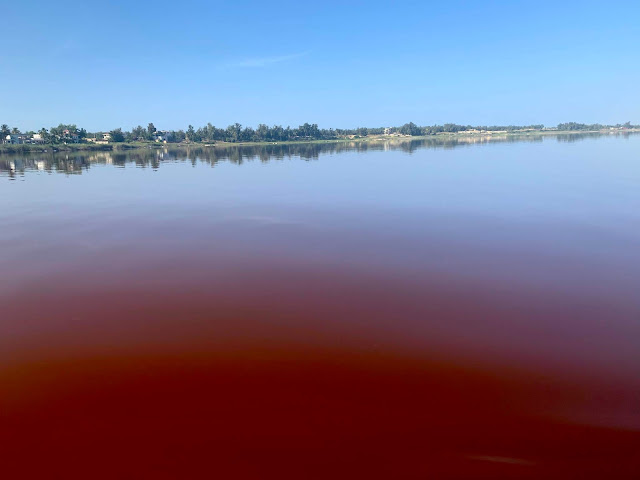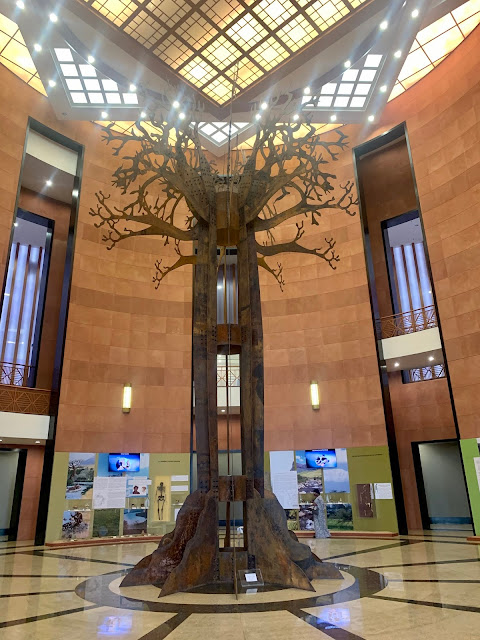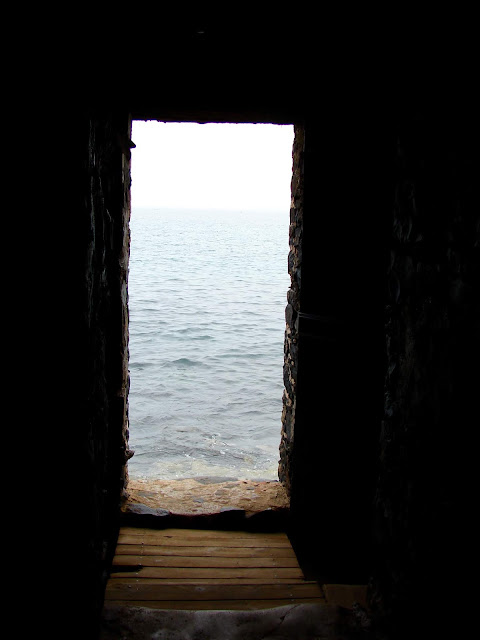Senegal: Then and Now
When is a pink lake not a pink lake?
Before addressing this riddle, I should probably clarify a couple of things. When I say pink lake, I am not referring to the ones in Australia, Canada or Azerbaijan. My focus is on Lake Retba aka Lac Rose in Senegal.
This is because I was recently spending some time in Dakar and thought it might make for a worthy outing. A Google maps search revealed it was less than a 30 minute drive so I thought it was strange when the hotel concierge booked our driver for 3 hours. Maybe there was a lot to see along the way.
The truth is that Google maps has no idea what Senegalese roads or traffic look like. In theory, I guess you could cover twenty kilometers in 20 minutes or so but that theory would have to discount dirt roads, traffic and the occassional goat.
It took us about an hour to arrive at Lac Rose's shores but I had seen enough vibrant Instagram pictures to know that it would be worth it.
Sure, there were a lot of pink boats parked before us and just as many boat men offering to take us for a spin around the lake. But why? What's to be gained by cruising around a fake pink lake?
Our driver, seeing the disappointment in our faces tried to explain the lake's seasonal nature- information that would have been helpful an hour earlier. The color is strongest during the dry season, which runs from November to June. Here we were in early November, the day after a heavy rain.
The boatmen persisted, until in a moment of frustration, I cried out "It's not a pink lake. Stop calling it that." His rebuttal was unorthodox. He picked up a rock and threw it into the water. Was this him letting the lake know that he was pissed?
But then a strange thing happened, pink concentric circles emerged from the spot where the rock had landed. What trickery was this? It was Dunaliella salina bacteria trickery is what it was. The bacteria creates a red pigment in order to absorb more sunlight. This same pigment is produced when the bacteria is agitated, for example when pelted by a rock.
Or when stirred by a boatman's oar...
Suddenly, we were in the middle of a pink freaking lake.
After thirty minutes of oaring around the lake- I gave it a shot for maybe 3 of those minutes- we were back where we started, staring at a non-pink lake.
By this time, people were getting off work and the beaches were packed with soccer players of all ages.
The vaguely sexist statue and its $27,000,000 price tag were a major source of controversy when it debuted but as with most signature architecture, it seems to be have been embraced and on this particular evening, was full of visitors.
An even more recent arrival is the Museum of Black Civilizations. It opened in December 2018 after receiving a $34 million gift from China for its construction.
The building itself is quite impressive, although the exhibits felt strangely spaced out. Part of the reason for this may be because the museum, which aims to represent black civilization's contributions throughout the world is engaged in a multi-front battle to reclaim Senegalese art taken during the colonial period. These works are currently on exhibit in museums around the world. So far, French president Emmanuel Macron has agreed to return 26 African treasures but I foresee that this battle will not end anytime soon.
It is estimated that over 15 million men, women and children passed through the door of no return to be loaded onto slave ships for the transatlantic journey, never to see their homeland again.
In addition to an incredibly powerful and moving museum, the island is also home to 1,600 residents and a good number of art galleries.
Before addressing this riddle, I should probably clarify a couple of things. When I say pink lake, I am not referring to the ones in Australia, Canada or Azerbaijan. My focus is on Lake Retba aka Lac Rose in Senegal.
This is because I was recently spending some time in Dakar and thought it might make for a worthy outing. A Google maps search revealed it was less than a 30 minute drive so I thought it was strange when the hotel concierge booked our driver for 3 hours. Maybe there was a lot to see along the way.
The truth is that Google maps has no idea what Senegalese roads or traffic look like. In theory, I guess you could cover twenty kilometers in 20 minutes or so but that theory would have to discount dirt roads, traffic and the occassional goat.
It took us about an hour to arrive at Lac Rose's shores but I had seen enough vibrant Instagram pictures to know that it would be worth it.
So why was I working so hard to find the faintest hint of a rose hue. This was, to my not-very-discerning eye, a decidedly normal looking lake.
Sure, there were a lot of pink boats parked before us and just as many boat men offering to take us for a spin around the lake. But why? What's to be gained by cruising around a fake pink lake?
Our driver, seeing the disappointment in our faces tried to explain the lake's seasonal nature- information that would have been helpful an hour earlier. The color is strongest during the dry season, which runs from November to June. Here we were in early November, the day after a heavy rain.
The boatmen persisted, until in a moment of frustration, I cried out "It's not a pink lake. Stop calling it that." His rebuttal was unorthodox. He picked up a rock and threw it into the water. Was this him letting the lake know that he was pissed?
But then a strange thing happened, pink concentric circles emerged from the spot where the rock had landed. What trickery was this? It was Dunaliella salina bacteria trickery is what it was. The bacteria creates a red pigment in order to absorb more sunlight. This same pigment is produced when the bacteria is agitated, for example when pelted by a rock.
Or when stirred by a boatman's oar...
Suddenly, we were in the middle of a pink freaking lake.
The lake itself is not very big, about one square mile and other than it's unique color, is not particularly scenic. Its main contribution to the region, other than as a tourism draw, is in its salinity. It is 40% salt, similar to the Dead Sea and is the source of salt mining.
 |
| Cold beer, pink lake, crazy hair, don't care. |
 |
| Pinks |
After a quick stroll through the maze of souvenir stands, we set off on our our hour-long return trip.
The timing and the crazy traffic actually worked in our favor in that we got to see Africa's tallest statue all lit up. The African Renaissance monument, which stands at 160 ft tall was completed in 2010. This means I had never seen it since my last visit to Senegal was in 2006.
The vaguely sexist statue and its $27,000,000 price tag were a major source of controversy when it debuted but as with most signature architecture, it seems to be have been embraced and on this particular evening, was full of visitors.
An even more recent arrival is the Museum of Black Civilizations. It opened in December 2018 after receiving a $34 million gift from China for its construction.
The building itself is quite impressive, although the exhibits felt strangely spaced out. Part of the reason for this may be because the museum, which aims to represent black civilization's contributions throughout the world is engaged in a multi-front battle to reclaim Senegalese art taken during the colonial period. These works are currently on exhibit in museums around the world. So far, French president Emmanuel Macron has agreed to return 26 African treasures but I foresee that this battle will not end anytime soon.
During my only other visit to Dakar, 13 years ago (and one year before I began this blog), there was no museum or giant statue but there was a monument to one of history's darkest periods. Goree Island, which is a short ferry ride from downtown, was once the largest slave-trading port on the African coast.
In addition to an incredibly powerful and moving museum, the island is also home to 1,600 residents and a good number of art galleries.
I had every intention of returning this time around but my schedule and that of the ferry never seemed to coincide. Ditto for trying to fit in a proper tour of the city or most upsetting of all, catching any Senegalese music.
 |
| A guard outside of the Presidential Palace. |
I remember that on my last visit, I had been eager to go to Youssou N'Dour's bar, where he often played. The problem was that it was Ramadan and all of the clubs were closed. Instead, many a helpful driver offered to take me to his house (or Baaba Maal's) because they knew his cousin/ uncle/ friend from school and I fear that these global superstars are constantly besieged by random tourists just appearing on their doorsteps. I also recall a resourceful concierge telling me he knew where I could hear live music. He took us a long ways out of town to a discreetly-hidden casino. I will never forget walking in, all excited to hear Sengalese music only to come face to face with a cover band. They were playing "The Rhythm is Gonna Get You". I'd been Estefan'ed!
In light of that disappointment, the pink lake that almost wasn't didn't seem so bad after all.































Comments
Post a Comment